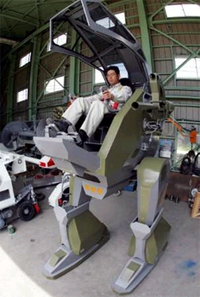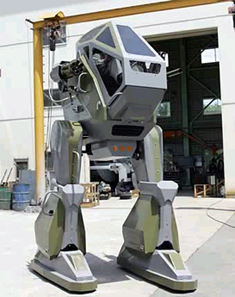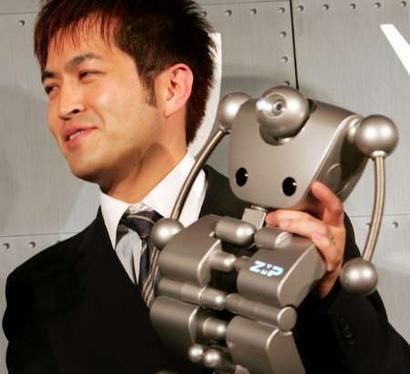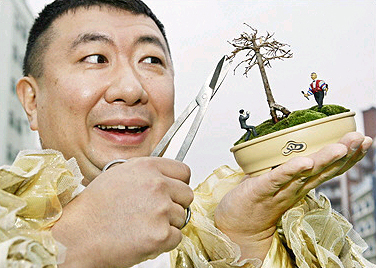


It was only a matter of time.
To even a casual observer, the robot is immediately apparent as permanent a fixture of postwar Japanese culture as the automobile and pop music are of the United States. The island nation took America's passing interest in the Robinson's Robot, Robbie, C-3PO, and R2-D2 and ran with it. Stateside children in the 1980s were deluged with Japanese cartoon programs following the adventures of human-piloted giant robots, from the legendary Voltron to the curious Tranzor Z and the moody but exquisite Robotech. American producers, entranced by the specialty transforming giant robot, offered two television shows of their own, Transformers and Gobots, each with an accompanying line of merchandise. As the decade waned, so did the novelty. When the generation that grew up watching the Super Dimensional Fortress One blast a Zentraedi fleet of calculator-busting numbers — and trying to master Rubik's Cubes like Broadside and Jetfire — stopped playing with toys, their successors took to different, if inferior, youthful diversions. The age of robots came and went.
Not so in Japan. What finds its way across the Pacific to our shores is often found tenfold over there. Would a Hovertechnics employee design a functional, russet hovercraft in honor of Luke Skywalker's landspeeder? Perhaps — though we've yet to hear of it. At Sakakibara Kikai, a national fascination landed on the drawing board:
An environment machinery maker has developed a robot that can be ridden and maneuvered like one in the animation series Mobile Suit Gundam, the company employee in charge of the development said Sunday. ...[Designer Masaaki] Nagumo, 32, developed the product over two years almost all by himself as he wanted to develop a robot that could be driven and operated to move like Gundam.
Aptly named Land Walker, the fully manual contraption tromps around and fires foam pellets right out of a ten-year-old's daydream. According to the Mainichi Shimbun, Land Walker can be had for a cool six figures but Sakakibara Kikai is happy to rent out its undoubtedly coveted services by the day. Obviously, a bipedal robot carries military potential — though Sakakibara would be prudent to consider the disadvantages of fictional counterparts. The six-story-tall Battle Pod, for instance, would require a thirty-foot-tall pilot; and the All-Terrain Scout Transport, though offering much simpler logistical requirements, performs miserably in forests boiling with excitable teddy bears armed with rocks, sticks and redwood lumber.
Until then, a few privileged Japanese children will remember a special birthday party for a long, long time.
CHIZUMANIA: I, for one, encourage Steven Den Beste to become the first man who regularly blogs from inside a San Diego-licensed, public park-trolling robot. For required additional equipment, a Raidar-X communications crest would be a nice touch. Auto body shops need a good challenge.
Want more? Kateigaho International Edition heralded the Expo 2005 Aichi with an authoritative historical account; and here, conjecture on the eternal question.

Leave it to the board of trustees of this fine weblog to compensate for what our chief officer insists is "a slight dip in production" with images and connotations that should help at least half of uBlog's readership forget all about philosophy in politics and enjoy their Friday.
In a curious trans-Pacific parallel, Japanese Prime Minister Junichiro Koizumi has, like President Bush, challenged his country's bureaucratic convention on a matter which all but the most sagacious and altruistic politicians would consider worth too little for the hefty investment of time and esteem. The trouble is ponderous, Twentieth-Century subsidy: in America, Bush moves to reform of Social Security; in Japan, Koizumi seeks subdivision and private administration of a sprawling Japan Post that, like a gargantuan zaibatsu conglomerate of old, provides citizens with everything from parcel delivery to savings accounts to life insurance. Like Bush, Koizumi enjoys a sizable if hesitant majority and a rhetorical advantage over his opponents but the prime minister has got one thing his Washington executive counterpart hasn't: a politically inclined corsetiere.
It seems Triumph International Japan Ltd. is so keen on placing the postman in the free market that the undergarment manufacturer thought it would try a memorable appeal for the private sector. Enter knockout Yu Misaki, who recently offered Tokyo fashion photographers an attractive solution for mailbox and letter carrier in one — two, rather. Triumph calls its little getup "Total Surprise Bra," complete with gratuitous exclamation point, and while the approach to grudge-match politics is novel the design and framing of argument are strikingly familiar. But it's effective. Koizumi could always use a push up in the polls, and this pledge of bipartisan support is a perfect fit.
Soccer, a whale and a crown prince in this week's standing ovation for the greatest thing that ever happened to domestic affairs.
Reconstituted, they'll make for a tasty, easily cooked meal. Suitably overcooked, some fish in Japan make for the perfect toiletry:
An ordinance prohibiting the release of black bass and other alien fish species back into Lake Biwa may help protect the lake's indigenous fish population, but it has also created a headache for locals over how to dispose of the unwanted fish. Help, however, has come from an unlikely new product, a deodorizer made from carbonized fish.Perhaps the black bass featured on the deodorizer's clever packaging sums it up best when he says, "We no longer eat crucian carp and ayu sweetfish, just odors."
What with the frustration of many American farmers and landowners, might some of this wisdom be applied to the long-ago imported avian juggernaut known as the European Starling?
Tokyo was host this Constitution Day weekend to the United Buddy Bears: six score life-size, radially arranged bear sculptures painted by artists from the country each one is supposed to represent. A traveling exhibition conceived by German artists in 2002, the Buddy Bears are intended to "[make] us understand one another better, trust each other more and live together more peacefully"; and for a rather naively symbolic exercise in geopolitical morality the Bears make for both a powerful statement of culture's craft and a sensational temporary landmark. From Afghanistan to Iraq to Lebanon to the Ukraine, each nation has an ursine stand-in. (The Russians resisted the temptation to make their final submission red.) As indicated by the photograph above, the Bears certainly appeal to young children — which can be applauded so long as tomorrow's world leaders don't exhibit mysterious predilections with foreign policies driven by fish, honey and annual hibernation cycles.
LITTLE MADRID: Switch species, replace thongs with a formidable pair of horns and we have Nagaoka's Japanese bull sumo.
Across all of the free world, long past civil wars are for cautionary plays, history buffs and costumed reenactors. Especially reenactors. Last week Japanese men and women of all ages came by the hundreds to suit up, close ranks and sprint into one another with the intention of pretending to rend anyone under the wrong banner limb from limb — as was the spirit of the times in the latter-15th and early-to-mid-16th Centuries before Toyotomi Hideyoshi unified the country under his rule.
You can't be lonely in this crowd. It doesn't exactly share the elegance of Ran, but must be good fun.

Here's robotics designer ZMP Inc. President Hisashi Taniguchi, holding one of his own Nuvo robots at an industry demonstration this past week. ZMP bills the breadbox-sized 'droid as a guardian of the home but press coverage has focused exclusively on the metal miniature's ability to dance.
Oh, how it dances. A webcam with barrettes for arms and it can massage the floor with its heels and toes until dawn — or whenever you return to the house from an errand. Nuvo responds to voice commands and can transmit image data via cellular phone bands like a mobile security camera. How a lemon-yellow sentry conceals or defends itself from a burglar who would just as well remove a witness and get some cash at the pawn shop in one grab is unknown. Presumably, the answer lies in dancing.
Confused? Perfect! This splash screen advertisement will perplex you even further. It's a full-on challenge to stuffy, bourgeois convention: do you really need to know what it does before you plunk down five grand?
So different, so alike. In following with the universal threads binding Japan and the West, we go from the transcendent to the mundane.
The crowd in uniform black was probably unfairly caught in an unflattering moment. No, no one always enjoys the early rise, the commute and the bustle but come pay day, hard work and hassles are readily justified.
If Japanese classes on children's road safety are remotely like our own, students quickly learn to be polite and courteous to their fellows, especially when driving in the play-city — but with the fleet invariably short several pedal carts, to walk a little faster and avoid being stuck with a tricycle.
Thanks to the Mainichi, we still get to revel in another world: sumo stars, Queen impersonators, stretch Coopers and a growing album of this year's cherry blossoms; this week's handshake with our one-of-a-kind, next-ocean neighbor.
It was only a matter of time: uBlog's "Only in Japan" and Steven Den Beste's Chizumatic collide when the Mainichi Shimbun's Photo Journal staff captures transpacific blockbuster animé DragonBall Z. Steven calls the marvelously terrible cartoon series his "kind of trash." I prefer Robotech but to each his own pulp, especially if it comes from the workbenches of the best.

When hunting for pictures of Japan I'm usually accosted by something respectfully eccentric or otherworldly. This scene from Tokyo is heartening in its familiarity: protesters using the occasion of bloodsoaked dictatorship Burma's "Anti-Fascist Resistance Day" to demand the human dignity sought, through threat, pain and imprisonment, by democratic champion and Nobel Laureate Aung San Suu Kyi. As explained by the Democratic Voice of Burma, Resistance Day celebrates the March 27, 1945 confrontation of invaders — a military force from a tyranny that is no more, in its place a democratic government reserving public space for this Tokyo march.
For a suitably industrious, part-time Santa Claus, it all started with such innocuity:
For centuries the Japanese have dwarfed trees in bonsai gardens which gained fame around the world. Now the delicate art is undergoing a revolution of sorts with some inspiration from Latin music, extraterrestrials and the realities of cramped apartments.The modern twist to bonsai began 20 years ago at a humble drain outside the home of Paradise Yamamoto, also known as Japan's top mambo musician. One day, Yamamoto was struck by the velvety beauty of the moss growing over the drain lid. Soon he started growing chunks of moss in a small container. When he put a miniature train on the moss, he realised something else — he no longer thought he was looking at a pot, but at a wide landscape from Japan's northern island of Hokkaido.
That's when the idea came to him: to make bonsai not just show trees, but scenes from life. Dubbed "Mambonsai," his art entails dwarfing not only trees but also statues to bring a less abstract dimension to bonsai.
The often comic results have drawn young people to bonsai, which had become a pastime largely of the elderly.
Genius being, of course, one part epiphany and two parts happy accident.

